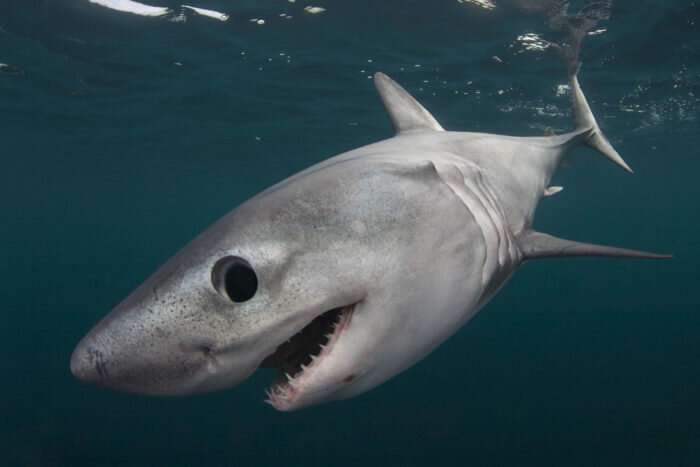Study dives deep into saving endangered shark

Mackerel sharks are large, fast-swimming apex predators that include Hollywood heavy-hitters like great whites (Jaws), mako (Deep Blue Sea) and the now-extinct Megalodon (The Meg). One of the smallest mackerel sharks is the porbeagle—on average less than two metres long—and it's one of the most critically endangered species of shark, too.
However, thanks to findings from a Western-led study, the porbeagles could be on its way to recovery after a half century of overfishing.
The study, Population structure and spatial distribution of porbeagles ( Lamna nasus ) in Irish waters, published by ICES Journal of Marine Science, includes valuable insights into porbeagle migratory patterns which will help shape long-term solutions for population management.
In the Atlantic Ocean, porbeagles have two fairly distinct populations: off eastern Canada between Newfoundland and South Carolina and a northeastern population between the Barents Sea (Norway-Russia) and Africa. The latter population has been listed as critically endangered by the International Union for Conservation of Nature (IUCN) due to a long history of overfishing and exploitation.
After the population in the northeastern Atlantic Ocean crashed (and commercial fishing of porbeagles was subsequently banned), fisheries continued on Canada's East Coast until 2013 and now this porbeagle population is also in danger.
Biology professor Paul Mensink, along with collaborators from Queen's University Belfast and Inland Fisheries Ireland, analyzed a long-term mark-and-recapture dataset from the Marine Sport Fish Tagging Programme which tagged 268 porbeagle sharks over 47 years, mainly in Irish waters. A collaboration between Inland Fisheries Ireland and recreational anglers, it is one of the longest-running shark tagging program in the world, with more than 40,000 individual sharks tagged.
The dataset revealed that Irish waters may act as a persistent summer gathering site for juvenile porbeagles, and that those juveniles may return to the same or nearby sites year after year. Remarkably, one of the tagged sharks moved from Ireland all the way to Canada, marking the first time this type of transatlantic movement had ever been recorded.
"It's incredible; there are 71 species of elasmobranchs—species like sharks, rays and skates—in Irish waters and several of them are now critically endangered," Mensink said. "Our study demonstrates how citizen science programmes can help provide the vital information we so desperately need to develop robust and effective management plans for these species."
The study also showed that porbeagles appear to be arriving into northern Irish coastal waters earlier and earlier each year, potentially indicating a shift in their long-term migratory movements.
William Roche from Inland Fisheries Ireland says, "This study shows the value of such long-term tagging programmes and highlights the need for continued cooperation at the international level to safeguard this iconic shark species."
More information: Luke W J Cameron et al. Population structure and spatial distribution of porbeagles (Lamna nasus) in Irish waters, ICES Journal of Marine Science (2019). DOI: 10.1093/icesjms/fsz046
Provided by University of Western Ontario


















